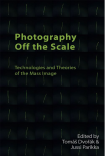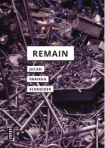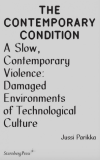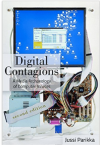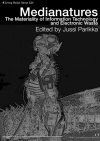Archive
First signs
First signs of Operational Images existing as a printed book.

Forthcoming in 2023: Operational Images
First signs of my forthcoming book Operational Images: From the Visual to the Invisual are online. Featured in the University of Minnesota Press new Spring /Summer 2023 catalogue.

An in-depth look into the transformation of visual culture and digital aesthetics
First introduced by the German filmmaker Harun Farocki, the term operational images defines the expanding field of machine vision. In this study, media theorist Jussi Parikka develops Farocki’s initial concept by considering the extent to which operational images have pervaded today’s visual culture, outlining how data technologies continue to develop and disrupt our understanding of images beyond representation.
Charting the ways that operational images have been employed throughout a variety of f ields and historical epochs, Parikka details their many roles as technologies of analysis, capture, measurement, diagramming, laboring, (machine) learning, identification, tracking, and destruction. He demonstrates how, though inextricable from issues of power and control, operational images extend their reach far beyond militaristic and colonial violence and into the realms of artificial intelligence, data, and numerous aspects of art, media, and everyday visual culture.
Serving as an extensive guide to a key concept in contemporary art, design, and media theory, Operational Images explores the implications of machine vision and the limits of human agency. Through a wealth of case studies highlighting the areas where imagery and data intersect, this book gives unprecedented insight into the ever-evolving world of posthuman visuality.
See here for the preface to the book.
The cover image includes a detail from Maria Constanza Ferreira’s video work.
Antikythera
The new Antikythera program headed by Benjamin Bratton launches, and I am happy to be involved as affiliated faculty.
It is a “program reorienting planetary computation as a philosophical, technological, and geopolitical force” and you can check out the website for details as well as how to apply. The selected studio participants (Los Angeles) will be fully supported with a housing provision and a monthly stipend of 4000 USD per month. The program also covers the additional research and field trips.
Media Theory with the Terraformers
A new interview is out in the Strelka Mag. We conducted this discussion with Yulia Gromova in Moscow during my teaching gig at Strelka’s The Terraforming program in February. The interview also briefly touches on my brief that we executed with the program researchers: we inaugurated a new synthetic discipline called A Natural History of Logistics and related to the body of work in media theory, architecture, urbanism, etc. The idea was to tease out various historical and contemporary – actual and speculative – points of connections between systems often deemed “natural” and “technological” so as to problematise the division into the two, and also to understand the various affordances so-called natural systems have in relation to questions of infrastructure and logistics. This also then facilitated looking at the various material frictions in logistical systems in relation to territories, environmental concerns, political questions, etc. The results presented by the Strelka researchers of the Terraforming cohort 2019-2020 – from architects to designers to artists etc. – were really inspiring and impressive.
The interview in Strelka Mag also speaks of some other work, including on Geology of Media etc.
Models, Diagrams, and Working Objects: On Studio Tomas Saraceno
Here’s a video recording of my IKKM lecture. It focuses on Studio Tomas Saraceno and in parts, contextualises some of the work in relation to environmental humanities and media.
On Air, Inhale
I had the pleasure of contributing to Tomas Saraceno’s new show On Air at Palais de Tokyo with a short text for the publication as well as with a talk as part of the seminar on December 14th, which was organized by Filipa Ramos. The show itself moves from spiders and webs to air and balloons, from entanglements of the Anthropocene to the light materials of the Aerocene combining speculative design, investigation of materials and beautiful installation structures.

My short text for the catalogue was titled “Inhale”:
Inhale and you engage with history, not metaphorically, nor poetically but literally. Inhale the air of a city and you inhale its industrial legacy, its current transport system, its chemistry built at the back of technological progress. There’s more in the air and the sky than meets the eye. On the level of eyes, nostrils and skin, the city and its surroundings, it becomes a touch. It is inhaled, enters the body as haptic environment. It is the haptic environment in which one sees and encounters the surroundings as a large scale Air-Conditioning Show. It is history carried forward as chemistry. It is technology breathed in as minuscule particles. The air is the environment we have to somehow learn to address as one way to invent a breathable future.


Oodi Art Project: AI and Other Intelligences
As part of our curatorial project on Library’s Other Intelligences we received an exclusive sneak preview of the new Helsinki Central Library, Oodi. With Shannon Mattern, Ilari Laamanen (Finnish Cultural Institute New York) and our artists we were able to see how the insides are shaping up. The aesthetically and architecturally stunning building is also such an interesting cluster of spaces that one could write about them much more extensively than just a this short posting. That longer piece might follow later, but already now I personally was struck how they deal with media in its multiple forms from analog to digital, from projection to making. From a cinema theatre equipped with also 35 and 70 mm projecting opportunities to a bespoke space for an analog synthesiser, the library offers an amazing platform for a public engagement with media which also includes recording studio space and a maker space – and yes, even a kitchen. The library is catered as a space of media transformations. At the moment the building exposed its multiple wires, cables, ducts and work – the labour of construction as well as cleaning that is already going on for the launch in December.
The top floor is reserved for what one would imagine as the “traditional” library, a space for books and reading, which also opens up to a terrace overlooking the Finnish parliament building. The roof wave is pretty stunning.


I wanted to include some of the visual impressions from the space that shows its infrastructure being built up, a theme that is present in some of the works from the artists Samir Bhowmik, Jenna Sutela and Tuomas A. Laitinen. In general, a key theme of our project concerns architectures and infrastructures of intelligence – both engaging with AI but as an expanded set of intelligences from architectural intelligence to ambient intelligence, from acoustics to amoebas and others layers of an ecology of a library that is a life support system – biologically, intellectually and culturally. It’s these multiple AIs that define the generative forms of languages, materials, and new publics that are present in how we want the space to be perceived. The exhibition opens in January 2019. Updates on social media will use the hashtag #OodiIntel.



Underground the White Mountain
I was invited to talk at the Serpentine Gallery’s Miracle Marathon this year. My take on the theme was to talk of the underground and the occult worlds of the long legacy of the Cold War. I performed with Emma Charles’ film White Mountain. Here’s the video of the talk.
More about Charles’ film in a short story in the new magazine issue of Postmatter.
The same magazine issue includes a new interview with me: Fossils of the Future.
Terms of Media 2: Actions
Part two of the Leuphana University and Brown University collaboration “Terms of Media” is taking place in October in Providence, US. I am extremely glad to be part of it, talking in the section “Remain”. If all goes as planned, the talk will move from the “remains” or “remainder” in the sense of the archival and the epistemological to emphasize issues of remains of media technologies in actioned situations. Remains are not merely of the archival, but part of a design brief with a hands-on relation to epistemology; labs, studios that address the remain as in the context of media archaeology but also design, sometimes implicitly, sometimes explicitly. The remainder becomes further detached from a nostalgic object to an issue that relates to contemporary ecologies of architecture, extended urbanism, supply chains and the “alternative worlds, alien landscapes, industrial ecologies and precarious wilderness” (Unknown Fields). I also will try to conclude with a mention of the methodological and thematic dilemma of infrastructural remains with a hat tips to Shannon Mattern and Unknown Fields (Liam Young & Kate Davies).
Below more info about the conference!
TERMS OF MEDIA 2: Actions
Brown University
October 8-10, 2015
with Marcell Mars, Rick Prelinger, Lisa Parks, Claus Pias, Timon Beyes, Reinhold Martin, Jussi Parikka, Rebecca Schneider, Goetz Bachmann, Lisa Nakamura, Gertrud Koch, Bernard Stiegler, Finn Brunton, Mercedes Bunz, Wolfgang Hagen, Eyal Weizman, Kara Keeling, Luciana Parisi
Please forward any questions to termsofmedia@brown.edu
RSVP HERE: https://goo.gl/csrNhR
An international conference to analyze and reshape the terms—limits, conditions, periods, relations, phrases—of media.
“Media determine our situation,” Friedrich Kittler infamously wrote in his introduction to Gramophone, Film, Typewriter. Although this dictum is certainly extreme – and media archaeology has been critiqued for being overly dramatic and focused on technological developments – it propels us to keep thinking about media as setting the terms for which we live, socialize, communicate, organize, do scholarship etc. After all, as Kittler continued in his opening statement almost 30 years ago, our situation, “in spite or because” of media, “deserves a description.” What, then, are the terms of media? And, what is the relationship between these terms and determination?
This conference will serve as the concluding half of a two-part project, following an earlier conference at Leuphana University in Lüneburg, Germany, and will be followed by a series of publications based on each which will seek to repose and update these fundamental questions of media theory: Does our situation indicate a new term, understood as temporal shifts of mediatic conditioning, which deserves a re-description? How and on what terms are media changing, reflecting changes in media itself? What are the terms of conditions that we negotiate as subjects of media? How do the terms of media theory relate to such conditions? What are the terms of conditions of media theory itself?
Thursday Keynotes to be held in the Martinos Auditorium, Granoff Center:
154 Angell Street
Providence, Rhode Island 02906 USA
Remaining talks to be held at Pembroke Hall:
172 Meeting Street
Providence, Rhode Island 02906 USA
Schedule is as follows:
Thursday, October 8, 2015
Conference Introduction, 7 p.m.
• Wendy Hui Kyong Chun, Professor and Chair, Department of Modern Culture and Media, Brown University
Keynote Address, 7:15 p.m.
• Marcell Mars, Public Library Project
• Rick Prelinger, Professor of Film and Digital Media and Board Member of the Internet Archive, University of California, Santa Cruz
Opening Reception, 9 p.m.
Friday, October 9, 2015
Session 1: Structure, 10 a.m. – 11:30 a.m.
• Lisa Parks, Professor of Film and Media, University of California, Santa Barbara
• Claus Pias, Professor for Media Theory and Media History, Institute of Culture and
Aesthetics of Digital Media, Leuphana
Session 2: Organize, 11:45 a.m. -1:15 p.m.
• Timon Beyes, Professor of Design, Innovation and Aesthetics, Copenhagen Business
School
• Reinhold Martin, Professor of Architecture, Planning and Preservation, Columbia
University in the City of New York
Lunch, 1:15 p.m. -2:30 p.m.
• Presenters and invited guests
Session 3: Remain, 2:30 p.m.-4:00 p.m.
• Jussi Parikka, Professor in Media & Design, University of Southampton
• Rebecca Schneider, Professor, Theatre Arts and Performance Studies, Brown University
Session 4: Work, 4:15 p.m.-5:45 p.m.
• Goetz Bachmann, Professor for Digital Cultures, Institute of Culture and Aesthetics of
Digital Media, Leuphana
• Lisa Nakamura, Professor, Departments of American Cultures and Screen Arts and
Cultures, University of Michigan
Conference Dinner, 7 p.m.
• Presenters and invited guests
Saturday, October 10, 2015
Session 1: Animate, 10 a.m. – 11:30 a.m.
• Gertrud Koch, Visiting Professor, Department of Modern Culture and Media, Brown University
• Bernard Stiegler, Head, Institut de recherche et d’innovation, Centre Georges Pompidou
Session 2: Communicate, 11:45 a.m. -1:15 p.m.
• Finn Brunton, Assistant Professor, Department of Media, Culture and Communication,
New York University
• Mercedes Bunz, Senior Lecturer, Communication and Media Research
Institute, University of Westminster
Lunch, 1:15 p.m. -2:30 p.m.
• Presenters and invited guests
Session 3: Forecast, 2:30 p.m.-4:00 p.m.
• Wolfgang Hagen, Professor, Institute of the Culture and Aesthetics of Digital Media,
Leuphana University
• Eyal Weizman, Professor of Spatial & Visual Cultures, Goldsmiths, University London
Session 4: Mediate, 4:15 p.m.-5:45 p.m.
• Kara Keeling, Associate Professor of Critical Studies and American Studies and Ethnicity, University of Southern California
• Luciana Parisi, Reader, Centre for Cultural Studies, Goldsmiths, University of London
TOKI-town
Istanbul is most often commented for its stunning beauty in a manner that approaches a modern touristic version of orientalism. For sure it is stunning, but the other side of Istanbul, as real but less visible, is the barbed wire protecting upper middle class & luxury housing areas, security cameras, traffic queues, and TOKIs. Indeed, urban planning and Istanbul is such a rich case study not merely if one is interested in Turkey but global capitalism and megacities in general.
To quote a recent MoMA-exhibition Uneven Growth:
“TOKI development parallels the emergence of a new middle class in Istanbul for whom a TOKI flat is part of a dream of car and house ownership, even if this brings social isolation, long hours in traffic, and long-term debt.”
 (Image from Moma/Uneven Growth.)
(Image from Moma/Uneven Growth.)



